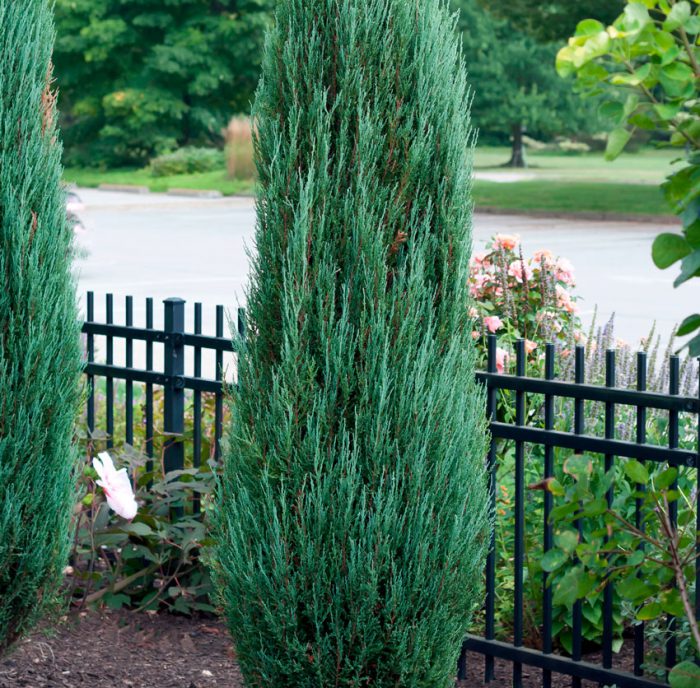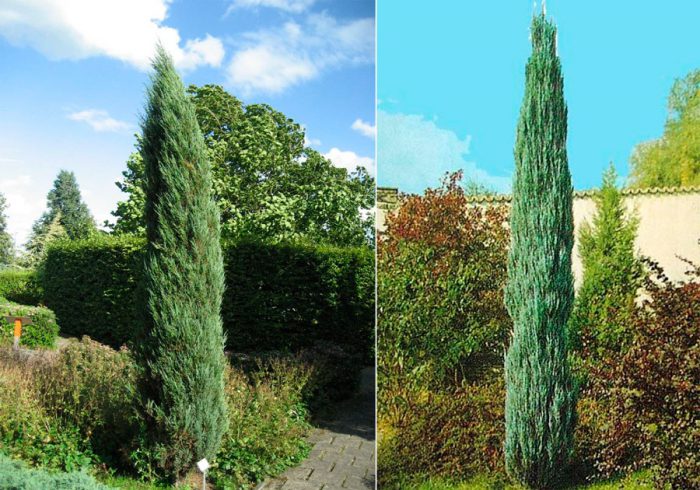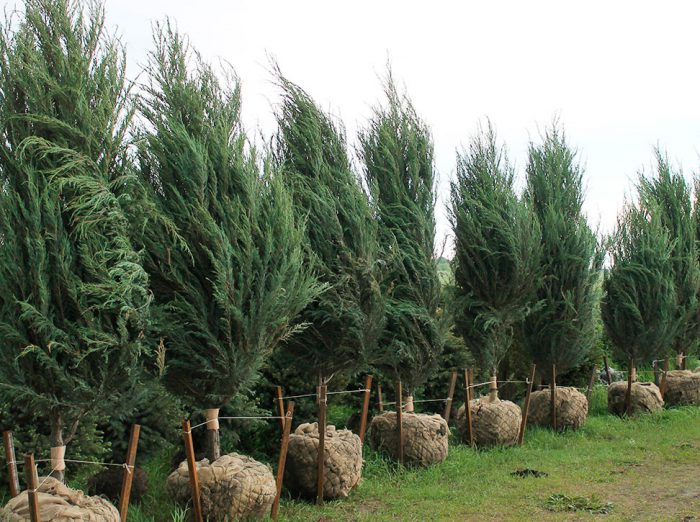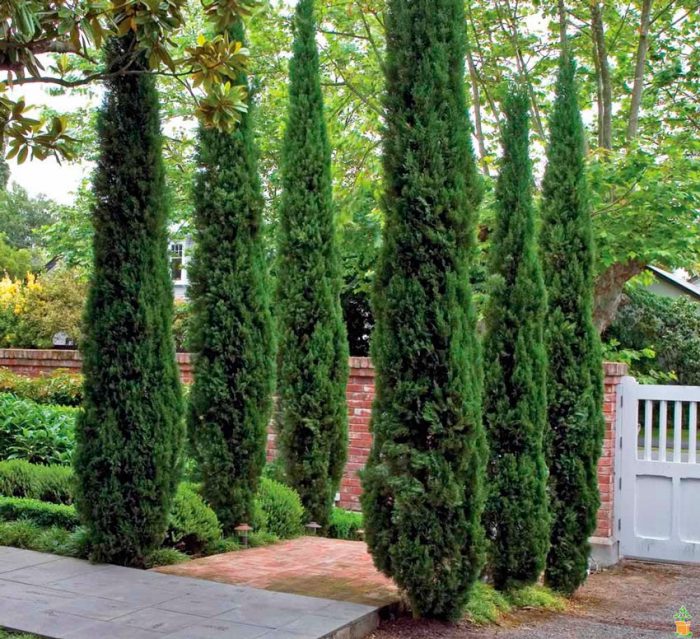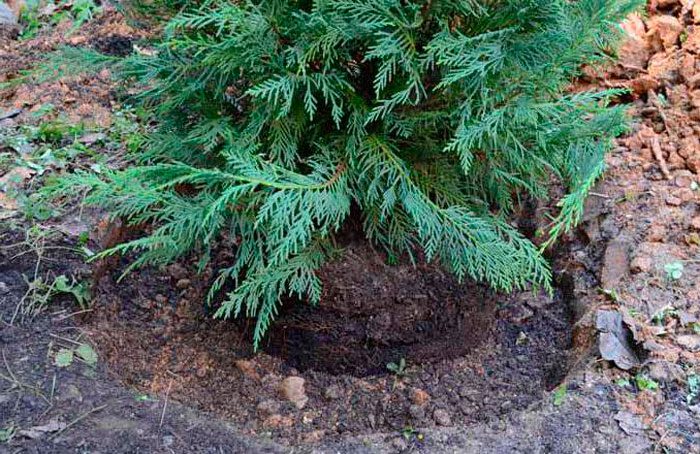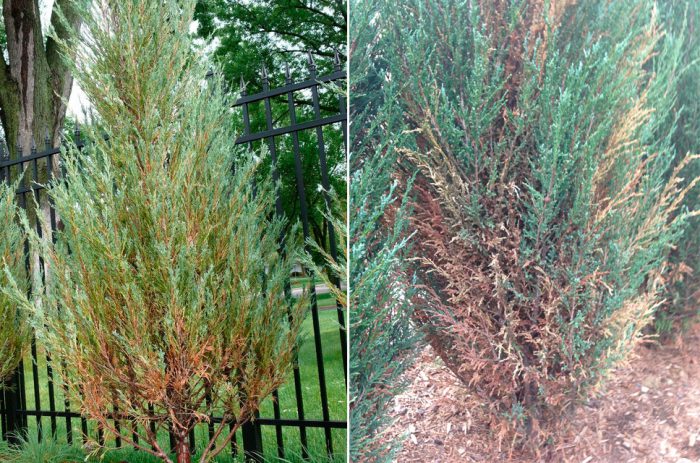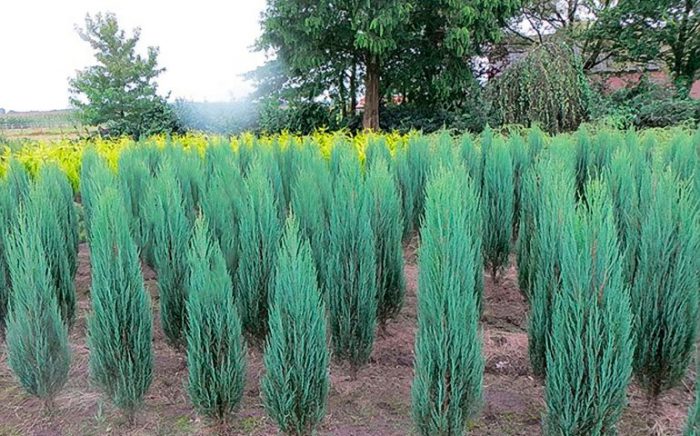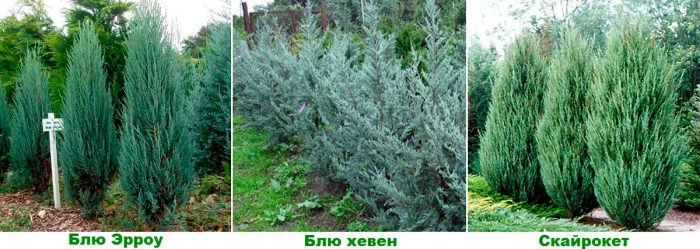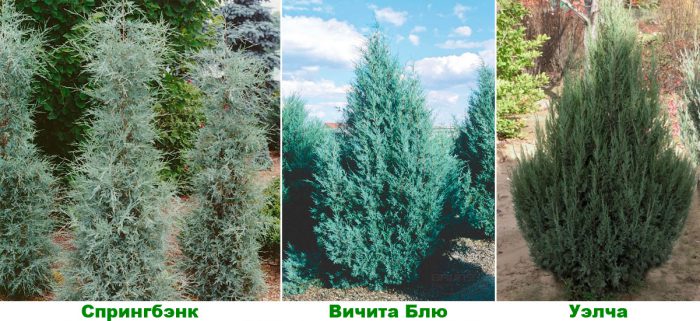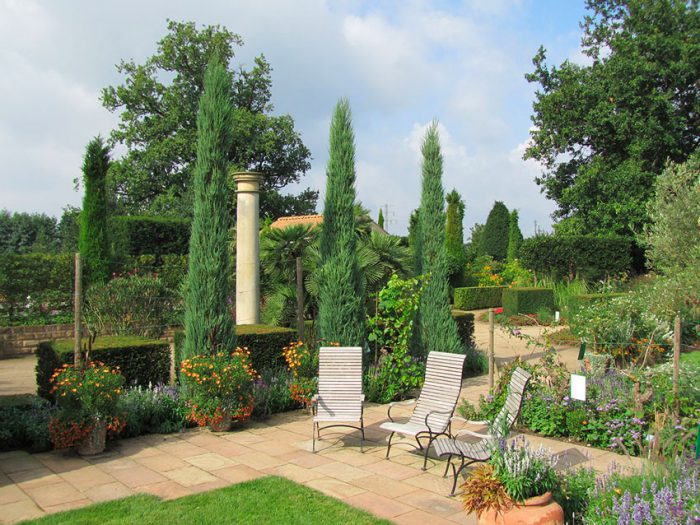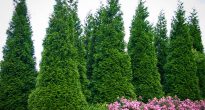Rock juniper (Juniperus scopulorum) is part of the genus Juniper, which belongs to the cypress family. In nature, such a plant can be found in Canada (in southwestern Alberta and British Columbia), in the United States (in west Texas, in Oregon and in northern Arizona), and also in northern Mexico. It prefers to grow on the rocky ground of the mountains at an altitude of 1200-2700 meters above sea level. This type of juniper is cultivated relatively rarely.
Content
Features of rocky juniper
The rocky juniper is represented by shrubs and dioecious trees. Under natural conditions, such a plant can have a height of 10–18 meters, and the girth of its trunk varies from 0.8 to 2 meters. However, the juniper growing in the garden is not so tall and thick. In this plant, the crown begins almost from the base, its shape is irregular conical, while over the years it becomes rounded. The color of the bark is brown. Young stems are colored pale blue or greenish blue. Opposite ovoid-rhombic leaf plates are usually scaly, 0.2 centimeters long and 0.1 centimeters wide. The color of the leaves is dark green, green-gray or gray-blue. This plant has needle-shaped needles, its length is 1.2 centimeters, and its width is 0.2 centimeters. Spherical cones are dark blue with a bluish bloom, their length is 0.4-0.6 centimeters. Only at the end of the second year will they fully mature. Inside the cone berries are brown-red ribbed seeds, which are about 0.5 centimeters in diameter.
Planting rocky juniper
If you have purchased a rocky juniper seedling with a closed root system, then it can be planted at any time of the year except winter. In the event that the seedling has an open root system, then it is recommended to plant it in open ground at the very beginning of the spring period after the soil is well warmed up, but the sap flow should not start yet.
In the event that if you strictly follow the agrotechnical conditions of this type of juniper, then it will be quite simple to care for it. When choosing a site for planting, it should be taken into account that it must be open and well lit, and the groundwater must lie deep enough.If the variety is dwarf, then a site with poor soil should be chosen for it, otherwise such a juniper will not be undersized. High varieties of juniper are recommended to be grown in nutritious soil. Also note that this plant needs a lot of space.
The size of the hole for planting should be at least 2 times the volume of the seedling root system. If the seedling is a dwarf variety, then a distance of 50 centimeters should be observed between the bushes. When planting tall plants, leave at least 200 centimeters of empty space between the specimens, the fact is that after 10 years such a juniper begins to grow actively. At the bottom of the pit, it is necessary to make a drainage layer, the thickness of which should be 20 centimeters, for this you can use crushed stone or broken brick. It is recommended to immerse the seedling together with the container a few hours before planting in a container with water. This way, you can gently remove the plant from the container without damaging its root system. In the event that you can plant a seedling along with a clod of earth, it will be much easier for a juniper to take root.
The seedling must be lowered into a pit, which is covered with a previously prepared earth mixture, consisting of peat, turf and sand (2: 1: 1). The planted plant needs abundant watering. After the liquid is completely absorbed into the soil, the surface of the trunk circle will need to be covered with an eight-centimeter layer of mulch (chips, peat, sawdust or pine bark). The root collar of the planted seedling should be at the level of the surface of the plot.
Rocky juniper care
It is quite easy to care for rocky juniper, as it is distinguished by its unpretentiousness and resistance to urban conditions. But it should be borne in mind that in the first years after planting, the plant will grow extremely slowly.
Mature bushes need to be watered only during prolonged drought. However, the juniper can be watered no more than three times per season. Newly planted seedlings need to be watered more frequently. It is also recommended to spray seedlings with lukewarm water, and this should be done in the evening.
You cannot feed this plant with organic matter. For young bushes, just one top dressing is enough, which is arranged in April or May, for this they use Kemiru-universal (for 1 bucket of water 20 grams) or Nitroammofosku (for 1 square meter from 30 to 40 grams). You do not need to feed adult bushes.
Caring for a rocky juniper in winter depends on the variety. If the bush has a columnar crown, then after a heavy snowfall, it is imperative to remove the snow from it by shaking it off, otherwise the branches may not withstand such a weight and break. In order to prevent injury to the branches, they must be pulled together with twine before heavy snowfall so that they are pressed against the trunk.
Transfer
If you transplant a juniper without following the rules, then it can ruin it. The reason for the death of the plant in this case lies in the severe damage to the root system. Adult large bushes are the hardest to transfer. What are the rules that allow you to transplant a plant without severe damage? The most important rule is to preserve the integrity of a clod of earth when digging up a bush, because it is in it that the plant's root system is located.
It is recommended to transplant in March – April or June – July, because it is at this time that the plant has the maximum root-forming ability. But still, in the summer, it is better to refrain from transplanting, since in the heat the needles evaporate a large amount of liquid, which leads to a significant weakening of the juniper, as well as to a slowdown in its adaptation. In this regard, it is best to transplant in the spring, but if time is running out, then you can transfer the bush to a new place in the fall during the fall.
Dig a pit for a start, and do not forget to take into account the size of the earthen lump of the bush. Then a good drainage layer must be made at its bottom. Prepare the required amount of soil mixture with which you will fill the pit. When everything is ready, you can start extracting the bush from the ground. To do this, you need to dig it in, not forgetting to step back from the trunk at least 50 centimeters. The juniper extracted with a lump of earth must be laid on a strong cloth or film, then it is carefully moved to a new planting site. You need to plant a dug bush in the same way as a seedling during the initial planting. The surface of the trunk circle must be covered with a layer of mulch, and do not forget that the transplanted plant needs protection from direct sunlight.


Watch this video on YouTube
Diseases and pests
Very often, such a plant becomes infected with rust, which is a fungal disease. In an infected specimen, growths of a rich orange color appear on the branches, they contain oil with a pigment, which is very similar in composition to carotene. The infected bush loses its spectacular appearance, its branches begin to dry out. A few years later, such a bush dies. If you notice the first signs of rust, then in the very near future, cut and destroy all affected parts of the plant, and then treat the juniper with a fungicide. Experts advise in this case to use such effective drugs as: Bayleton, Skor, Rogor, Vectra and Tilt.
Also, quite often the juniper bush affects fusarium wilting (tracheomycosis). Its development is very often associated with the fact that the plant is grown in overly dense soil with high humidity. This disease affects the root system of the plant, which stops transferring nutrients to the aerial parts of the plant. The fact is that the mycelium of the fungus grows into the vascular system of the juniper. In the affected bush, the apical shoots are the first to dry out, their needles change their color to pale red. After some time, the disease affects the entire bush. It is almost impossible to detect the development of fusarium wilting at an early stage, however, if you notice that the apical shoots of the bush have become yellow or red, then immediately cut off the infected branches and treat the plant and the soil surface under it with a fungicide. For a greater effect, experienced gardeners recommend changing the topsoil to fresh soil mixture, which must be saturated with a fungicide solution. In order to prevent the purchased material for planting, it is imperative to subject it to processing with Quadris, Fitosporin-M or Maxim, not forgetting about the earthen lump. If the seedling is not very large, then its root system must be immersed in Maxim's solution for 2 or 3 hours.
Also, a juniper can lose its spectacular appearance or even die from a disease called branch drying. It is possible to understand that the bush is infected in springtime, its needles turn yellow and begin to die off, at first it affects not very large areas, but over time the disease spreads to the entire juniper or to most of it. As the disease progresses, small fruiting bodies of fungi form on the surface of the bark and needles. A diseased bush should be started to be treated immediately, as the first signs of drying out of the branches were noticed. To do this, cut off all branches with yellow needles, and the plant itself must be treated with a fungicide solution. In the event that the juniper is very severely affected by the disease, then it will have to be dug up and destroyed. For prevention purposes, it is necessary to spray the bush 2 times per season, namely: in the second half of April and in the last days of October, for this they use Tilt, Ridomil Gold MC or Skor.
Another rocky juniper is able to get infected with brown shute (the name is derived from the German word, which translates as "crumble"). In the affected specimen, the needles turn yellow and fall off. Most often, the disease makes itself felt in the first summer weeks. If you look at the infected needles in the last days of August, then on its surface you can see the fruit bodies of mushrooms of an ellipsoid shape and black color. If the juniper is improperly taken care of or grown in the shade, as well as in a damp place, in these cases the disease will develop rapidly. Branches with yellowed needles must be cut off, and also remove all dead needles that have fallen to the site, then process the copy with Strobi, Skor, Quadris or Ridomil Gold MC. For the purpose of prevention, the bushes should be treated with these drugs in mid-April and in the autumn before frosts begin.
Pests such as miner moths, scale insects, aphids, as well as spider mites can harm this plant. To get rid of aphids, the bush must be sprayed with Fitoverm solution, which is prepared according to the instructions. If a mole has settled on the plant, then it needs to be treated with a Decis solution (for 1 bucket of water 2.5 grams), and you can get rid of the scabbard with a solution of Karbofos (for 1 bucket of water 70 grams of substance), which needs to be treated both the bush itself and the surface of the ground below it. Spider mites are afraid of acaricidal agents, for example: Karbofos, Aktellik, Aktara and others that have a similar effect.
Juniper pruning
Formative pruning is not needed for rocky juniper, because its crown has a very spectacular shape from nature. However, he needs sanitary pruning. How to prune a bush correctly? Pruning is carried out in early spring, before sap flow begins, and a rainy day is chosen for this. All dried, injured, damaged by disease or pests should be removed, stems and branches, as well as those that do not grow properly. If you want to align the contours of the crown, then remember that you can shorten branches and stems by no more than 20 mm, since the growth of this plant is only 10 centimeters per year.


Watch this video on YouTube
Reproduction of rocky juniper
Rocky juniper can be propagated by young layering, cuttings or grafting. Cuttings are harvested in the spring; for this, the semi-lignified upper shoots with a heel are cut off (this is a small piece of wood of the branch from which the shoot grows). Cuttings are rooted in a greenhouse. After they take root, they should be planted on a training bed. Depending on the type of plant and the age of the cutting, it can take 1.5-6 months to take root. It takes 3-6 years to grow it in a school.
For propagation by layering, only creeping forms are suitable. The stem must be cleaned from the needles and fixed on the surface of the soil with a near-stem circle, which must be prepared in advance. After 6-12 months, they will fully take root. Rooted layers must be cut off from the mother bush and planted on a training bed, placed in a shaded place, for growing.
It is quite difficult to propagate this type of juniper by grafting, since certain professional skills are required.
Rocky juniper varieties with photos and names
Thanks to the work of American breeders, a large number of rock juniper varieties were born, and all of them are quite popular among gardeners. Varieties that are suitable for growing in mid-latitudes will be described below:
- Blue Air... The height of the bush varies from 150 to 250 centimeters, the crown is columnar narrow, its width is about 0.5 meters. The needle-shaped scaly green-blue needles have a steel sheen.
- Blue Haven... The height of the bush is about 200 centimeters. Its pyramidal crown reaches 100 centimeters wide.The color of the needles throughout the year is light blue with a steel shade.
- Skyrocket... This winter-hardy variety is quite popular among gardeners. When the plant is 10 years old, its height will reach 3–6 meters. The columnar habit is narrow and slender. Straight stems are adjacent to the trunk. The needles are greenish-gray, usually scaly. This variety is susceptible to fungal diseases.
- Moffat Blue... This winter-hardy variety has a dense, wide-pyramidal crown. The color of the needles is greenish blue. Plant height 3-6 meters, and the width of its crown reaches 100-130 centimeters. This variety cannot be grown in humid regions.
- Munglow... This variety has many similarities to Blue Haven. The crown of the plant is wide-pyramidal. At the age of ten, its height is 250 centimeters, while the crown reaches 100 centimeters wide. The needles have a rich blue-silver color, which looks even brighter in winter.
- Silver King... The bush has open branches. When he is 10 years old, he reaches a height of only 0.6 meters with a crown width of 2 meters. Blue-colored needles are usually scaly.

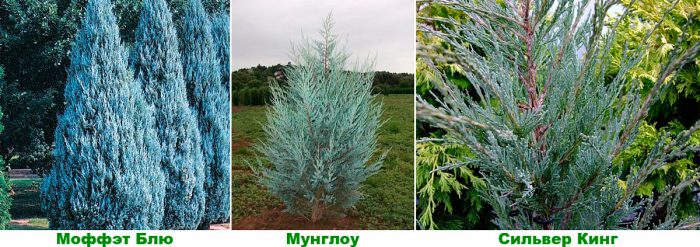
- Springbank... This variety is photophilous. The crown is narrow, columnar. The height of the bush does not exceed 4 meters. The ends of the stems are "disheveled", shaggy. Thin needles are blue-silver colored.
- Table Top Blue... The shape of the crown is oval. The color of the needles is blue-silver. The ten-year-old plant reaches a height of 200 centimeters, while the crown diameter is 250 centimeters.
- Welch... The dense crown has a pyramidal shape. The needles are greenish-blue with a silvery tint.
- Wichita Blue... The branches of the bush are open, and the color of the needles is bluish-silver. At the age of ten, its height does not exceed 0.4 m, while the crown width reaches 1.5 m.
In addition to the varieties described above, the following varieties of rocky juniper are cultivated by gardeners: Winter Blue, Tollesons Blue Whippin, Tollesons Green Whipin, Sutherland, Monwade, Medora, Greenspire, Erekta Glauka, Gray Glim, Colorado Green, etc.
Rocky juniper in landscape design
In landscape design, experts widely use rocky juniper. So, it is used for group and single plantings in rocky and heather gardens, such a plant is used to frame alleys, it is used to decorate small backyard gardens, and it is also used as a vertical accent in various floral arrangements.
The crown of the rocky juniper is quite effective due to the fact that it is geometrically correct and clear. It is often used as a background for other plants or as a central link in a garden composition. This plant is perfect for those plots that are decorated in English or Scandinavian style, and the juniper will also look great in alpine or Japanese gardens.

